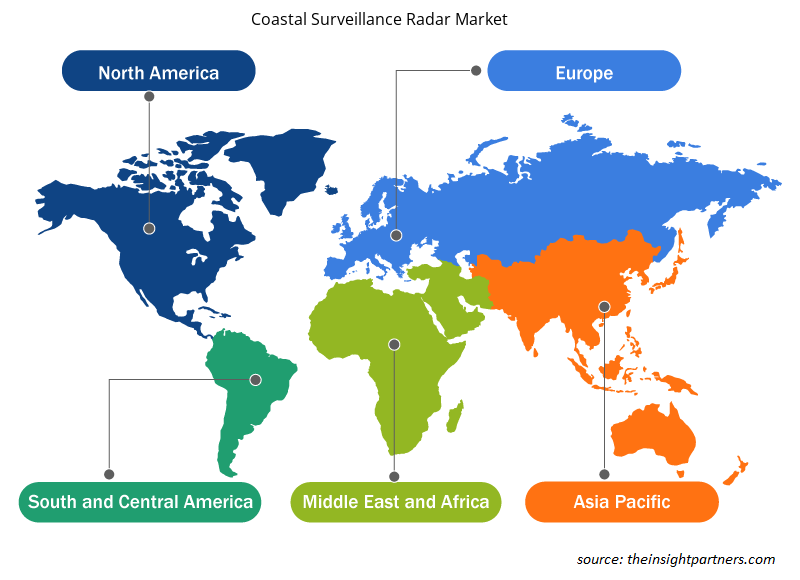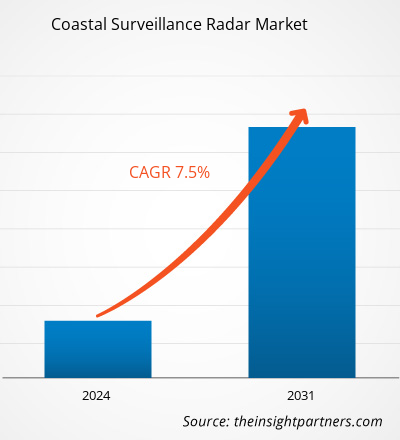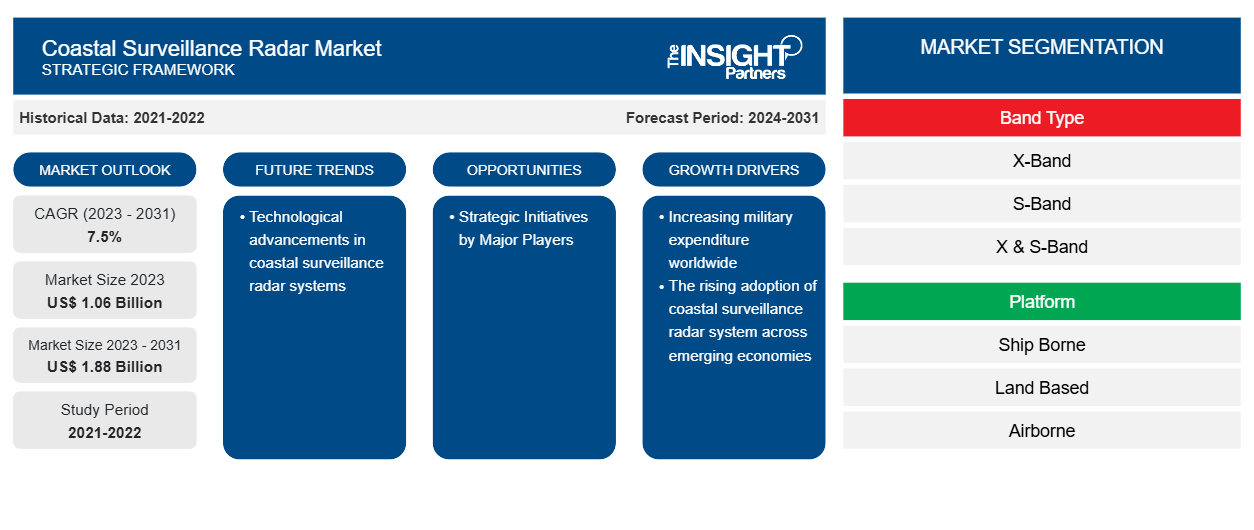Si prevede che la dimensione del mercato dei radar di sorveglianza costiera raggiungerà 1,88 miliardi di dollari entro il 2031 da 1,06 miliardi di dollari nel 2023. Si prevede che il mercato registrerà un CAGR del 7,5% nel periodo 2023-2031. È probabile che i progressi tecnologici nei sistemi radar di sorveglianza costiera rimangano una tendenza chiave nel mercato.
Analisi del mercato dei radar di sorveglianza costiera
Elbit Systems Ltd, Thales Group, Israel Aerospace Industries, Hensoldt AG e Terma A/S sono alcuni dei principali attori del mercato che operano nel mercato globale dei radar di sorveglianza costiera. Queste aziende si impegnano nello sviluppo di sistemi robusti, tra cui radar a banda X, a banda S e a banda X e S per vari utenti finali. Inoltre, queste aziende godono anche di un numero considerevole di contratti per i loro radar da varie forze navali, guardie costiere, compagnie petrolifere e del gas, nonché porti. Le aziende firmano accordi a lungo termine con gli utenti finali per supportare la fornitura di prodotti radar di sorveglianza costiera, il che consente alle aziende di generare entrate anno dopo anno.
Panoramica del mercato dei radar di sorveglianza costiera
I principali stakeholder nell'ecosistema del mercato globale dei radar di sorveglianza costiera includono produttori di componenti, integratori di sistema e utenti finali, tra gli altri. Un radar di sistema di sorveglianza costiera è costituito da vari componenti che vengono acquistati dai produttori di sistemi da un'enorme base di produttori di componenti. Questi produttori di componenti forniscono le parti di base ai player globali dei radar di sorveglianza costiera. Gli integratori di sistema sono le aziende che si occupano della produzione dei sistemi radar di sorveglianza finali dopo l'integrazione di ciascun componente. L'utente finale del mercato globale dei radar di sorveglianza costiera include sia gli enti governativi che le organizzazioni private che svolgono attività lungo la costa. Le multinazionali del petrolio e del gas on-shore che si trovano sulle coste dipendono fortemente dai radar di sorveglianza per garantire la sicurezza e la protezione delle loro operazioni e dei loro beni. D'altro canto, l'aumento della spesa militare da parte delle nazioni sviluppate e in via di sviluppo e i loro crescenti investimenti per proteggere sia i confini terrestri che quelli costieri da fattori come il traffico di droga, il terrorismo e gli immigrati clandestini, tra gli altri, sta anche spingendo l'elevata adozione del radar di sorveglianza costiera da parte degli enti governativi.
Personalizza questo report in base alle tue esigenze
Riceverai la personalizzazione gratuita di qualsiasi report, comprese parti di questo report, o analisi a livello nazionale, pacchetto dati Excel, oltre a usufruire di grandi offerte e sconti per start-up e università
- Scopri le principali tendenze di mercato in questo rapporto.Questo campione GRATUITO includerà analisi di dati che spaziano dalle tendenze di mercato alle stime e alle previsioni.
Driver e opportunità del mercato dei radar di sorveglianza costiera
Crescente adozione del sistema radar di sorveglianza costiera nelle economie emergenti
L'aumento delle minacce ai confini tra economie emergenti come Cina, India, Taiwan, Corea del Sud, Russia, Ucraina, Israele, Palestina e Iran dovrebbe aumentare l'adozione di sistemi radar di sorveglianza costiera. A causa dell'aumento della guerra marittima e delle insurrezioni oceaniche, le regioni costiere di queste economie stanno diventando sempre più vitali e il radar di sorveglianza svolge un ruolo cruciale nel rilevare le minacce in tempo reale. I comandanti possono ottenere informazioni preziose sui movimenti nemici e sui loro dintorni dispiegando sistemi radar avanzati lungo i confini costieri, adottando così le misure necessarie basate su dati in tempo reale. Questo vantaggio di raccogliere dati in tempo reale con immagini chiare e ad alta risoluzione è il punto di attrazione cruciale per gli utenti finali. Quindi, sulla base dei parametri cruciali, il mercato dei radar di sorveglianza costiera è cresciuto in tutto il mondo.
Iniziative strategiche dei principali attori
Le aziende che operano nel mercato dei radar di sorveglianza costiera stanno adottando strategie di crescita organiche e inorganiche, come investimenti elevati, offerte di prodotti ed espansione globale, creando ulteriori opportunità di crescita per il mercato globale dei radar di sorveglianza costiera. Alcuni sviluppi chiave da menzionare sono:
- A settembre 2022, la Guardia costiera statunitense ha assegnato un contratto a L3Harris Technologies Inc per un massimo di cinque radar multimodali AN/APY-11 che saranno installati sui nuovi aerei di sorveglianza a lungo raggio C-130J Super Hercules durante il processo di missione Minotaur. Il contratto a prezzo fisso è per la consegna di tre radar multimodali, che saranno installati da L-3 Communication Integrated Systems a Waco, Texas, durante la missione e l'aggiornamento Block 8.1 per il 18°, 19° e 20° aereo C-130J nella flotta della Guardia costiera.
- Nel dicembre 2022, la LIG Nex1 Co ha firmato un accordo con il Naval Logistics Command per il progetto Maritime Surveillance Radar-II.
Tali sviluppi hanno generato nuove opportunità per gli operatori del mercato in diverse regioni.
Analisi della segmentazione del rapporto di mercato del radar di sorveglianza costiera
I segmenti chiave che hanno contribuito alla derivazione dell'analisi di mercato del radar di sorveglianza costiera sono il tipo di banda, la piattaforma e l'utente finale.
- In base al tipo di banda, il mercato dei radar di sorveglianza costiera è segmentato in banda X, banda S, banda X/S e altri. Il segmento della banda X ha detenuto una quota di mercato maggiore nel 2023.
- In base alla piattaforma, il mercato dei radar di sorveglianza costiera è segmentato in imbarcati, terrestri e aerei. Il segmento aereo ha detenuto una quota di mercato maggiore nel 2023.
- In base all'utente finale, il mercato dei radar di sorveglianza costiera è segmentato in porti, compagnie petrolifere e del gas e agenzie di pattugliamento marittimo . Il segmento delle agenzie di pattugliamento marittimo ha detenuto una quota di mercato maggiore nel 2023.
Analisi della quota di mercato del radar di sorveglianza costiera per area geografica
L'ambito geografico del rapporto sul mercato dei radar di sorveglianza costiera è suddiviso principalmente in cinque regioni: Nord America, Europa, Asia Pacifico, Medio Oriente e Africa e Sud America.
Il Nord America ha dominato il mercato nel 2023, seguito da Europa e regioni dell'Asia Pacifica. Inoltre, è probabile che anche l'Asia Pacifica assista al CAGR più elevato nei prossimi anni. Gli Stati Uniti hanno rappresentato la quota di mercato più grande nel mercato dei radar di sorveglianza costiera del Nord America. Gli Stati Uniti sono anche un paese tecnologicamente avanzato e hanno un enorme potenziale per adottare nuove tecnologie nel corso degli anni. Le compagnie petrolifere e del gas presenti in tutto il paese hanno anche un enorme potenziale per adottare tecnologie per proteggere le loro operazioni lungo le coste. Ciò sta influenzando ulteriormente l'adozione di radar di sorveglianza costiera per limitare o restringere le attività illecite in tutto il paese. Accipiter Radar Technologies Inc, Teledyne FLIR LLC, L3Harris Technologies Inc, Raytheon Technologies Corporation e SSR Engineering sono alcuni degli attori che operano nel mercato statunitense.
Approfondimenti regionali sul mercato dei radar di sorveglianza costiera
Le tendenze regionali e i fattori che influenzano il mercato dei radar di sorveglianza costiera durante il periodo di previsione sono stati ampiamente spiegati dagli analisti di Insight Partners. Questa sezione discute anche i segmenti e la geografia del mercato dei radar di sorveglianza costiera in Nord America, Europa, Asia Pacifico, Medio Oriente e Africa e America meridionale e centrale.

- Ottieni i dati specifici regionali per il mercato dei radar di sorveglianza costiera
Ambito del rapporto di mercato del radar di sorveglianza costiera
| Attributo del report | Dettagli |
|---|---|
| Dimensioni del mercato nel 2023 | 1,06 miliardi di dollari USA |
| Dimensioni del mercato entro il 2031 | 1,88 miliardi di dollari USA |
| CAGR globale (2023-2031) | 7,5% |
| Dati storici | 2021-2022 |
| Periodo di previsione | 2024-2031 |
| Segmenti coperti | Per tipo di banda
|
| Regioni e Paesi coperti | America del Nord
|
| Leader di mercato e profili aziendali chiave |
|
Densità dei player del mercato dei radar di sorveglianza costiera: comprendere il suo impatto sulle dinamiche aziendali
Il mercato del Coastal Surveillance Radar Market sta crescendo rapidamente, spinto dalla crescente domanda degli utenti finali dovuta a fattori quali l'evoluzione delle preferenze dei consumatori, i progressi tecnologici e una maggiore consapevolezza dei vantaggi del prodotto. Con l'aumento della domanda, le aziende stanno ampliando le loro offerte, innovando per soddisfare le esigenze dei consumatori e capitalizzando sulle tendenze emergenti, il che alimenta ulteriormente la crescita del mercato.
La densità degli operatori di mercato si riferisce alla distribuzione di aziende o società che operano in un particolare mercato o settore. Indica quanti concorrenti (operatori di mercato) sono presenti in un dato spazio di mercato in relazione alle sue dimensioni o al valore di mercato totale.
Le principali aziende che operano nel mercato dei radar di sorveglianza costiera sono:
- Accipiter Radar Technologies Inc
- Aselsan AS
- Sistemi di sorveglianza Blighter Ltd
- Sistemi radar Easat Ltd
- Sistemi Elbit Ltd
- Teledyne FLIR LLC
Disclaimer : le aziende elencate sopra non sono classificate secondo un ordine particolare.

- Ottieni una panoramica dei principali attori del mercato dei radar di sorveglianza costiera
Notizie di mercato e sviluppi recenti del radar di sorveglianza costiera
Il mercato dei radar di sorveglianza costiera viene valutato raccogliendo dati qualitativi e quantitativi dopo la ricerca primaria e secondaria, che include importanti pubblicazioni aziendali, dati associativi e database. Di seguito sono elencati alcuni degli sviluppi nel mercato dei radar di sorveglianza costiera:
- Leonardo ha acquisito una quota del 30% del capitale sociale di GEM elettronica, azienda italiana specializzata nella produzione di radar 3D di piccole e medie dimensioni, sensori elettro-ottici e sistemi inerziali per i settori marittimo, aereo e terrestre. (Fonte: Leonardo, Comunicato Stampa, aprile 2021)
- Il fornitore di soluzioni di sensori HENSOLDT sta equipaggiando il National Security Cutter (NSC) di classe "Legend" della Guardia costiera statunitense con il suo collaudato radar navale multimodale TRS-3D. La Guardia costiera statunitense ha assegnato a HENSOLDT un contratto di follow-on del valore di circa 10 milioni di $ per la fornitura di un ulteriore radar nella sua ultima versione "Baseline D" da installare presso il centro di addestramento della Guardia costiera (TRACEN), Petaluma/CA. Finora, HENSOLDT ha consegnato 12 radar al programma NSC della Guardia costiera statunitense. (Fonte: HENSOLDT, comunicato stampa, settembre 2023)
Copertura e risultati del rapporto sul mercato dei radar di sorveglianza costiera
Il rapporto "Dimensioni e previsioni del mercato dei radar di sorveglianza costiera (2021-2031)" fornisce un'analisi dettagliata del mercato che copre le seguenti aree:
- Dimensioni e previsioni del mercato dei radar di sorveglianza costiera a livello globale, regionale e nazionale per tutti i principali segmenti di mercato coperti dall'ambito
- Tendenze del mercato dei radar di sorveglianza costiera e dinamiche di mercato come driver, limitazioni e opportunità chiave
- Analisi dettagliata delle cinque forze di Porter
- Analisi di mercato del radar di sorveglianza costiera che copre le principali tendenze del mercato, il quadro globale e regionale, i principali attori, le normative e i recenti sviluppi del mercato
- Analisi del panorama industriale e della concorrenza che copre la concentrazione del mercato, l'analisi della mappa di calore, i principali attori e gli sviluppi recenti per il mercato dei radar di sorveglianza costiera
- Profili aziendali dettagliati
- Analisi storica (2 anni), anno base, previsione (7 anni) con CAGR
- Analisi PEST e SWOT
- Valore/volume delle dimensioni del mercato - Globale, Regionale, Nazionale
- Industria e panorama competitivo
- Set di dati Excel
Report recenti
Rapporti correlati
Testimonianze
Motivo dell'acquisto
- Processo decisionale informato
- Comprensione delle dinamiche di mercato
- Analisi competitiva
- Analisi dei clienti
- Previsioni di mercato
- Mitigazione del rischio
- Pianificazione strategica
- Giustificazione degli investimenti
- Identificazione dei mercati emergenti
- Miglioramento delle strategie di marketing
- Aumento dell'efficienza operativa
- Allineamento alle tendenze normative





















 Ottieni un campione gratuito per - Mercato dei radar di sorveglianza costiera
Ottieni un campione gratuito per - Mercato dei radar di sorveglianza costiera